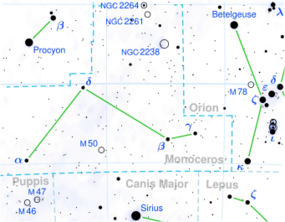Astronomy:UGPS J072227.51−054031.2
| Observation data Equinox J2000.0]] (ICRS) | |
|---|---|
| Constellation | Monoceros |
| Right ascension | 07h 22m 27.29s[1] |
| Declination | −05° 40′ 30.0″[2] |
| Characteristics | |
| Spectral type | T9[2] |
| Apparent magnitude (i (AB SDSS)) | 24.32 ± 0.12[3] |
| Apparent magnitude (z) | 20.51 ± 0.09[1][4] |
| Apparent magnitude (Y) | 17.37 ± 0.02[1] |
| Apparent magnitude (J) | 16.52 ± 0.02[1] |
| Apparent magnitude (H) | 16.90 ± 0.02[1] |
| Apparent magnitude (K) | 17.07 ± 0.08[1] |
| Apparent magnitude (L') | 13.4 ± 0.3[1] |
| Apparent magnitude (N) | 10.28 ± 0.24[1] |
| Astrometry | |
| Radial velocity (Rv) | 46.9 ± 2.5[4] km/s |
| Proper motion (μ) | RA: −904.14 ± 1.71[3] mas/yr Dec.: 352.025 ± 1.21[3] mas/yr |
| Parallax (π) | 242.8 ± 2.4[3] mas |
| Distance | 13.4 ± 0.1 ly (4.12 ± 0.04 pc) |
| Details | |
| Mass | (10.7 ± 0.2)—(25.8 ± 0.9)[5] MJup |
| Radius | (0.886 ± 0.005)—(1.0192 ± 0.0005)[5] RJup |
| Luminosity (bolometric) | (6.3 ± 0.4×10−7[5] L☉ |
| Surface gravity (log g) | (4.39 ± 0.01)—(4.90 ± 0.01)[5] cgs |
| Temperature | (502 ± 10)—(539 ± 12)[5] K |
| Rotational velocity (v sin i) | 40 ± 10[4] km/s |
| Age | 1–5[4] Gyr |
| Other designations | |
| Database references | |
| SIMBAD | data |
Location of UGPS 0722−05 in the constellation Monoceros | |
UGPS J072227.51−054031.2 (designation often abbreviated to UGPS 0722−05) is a brown dwarf of late T type, or possibly a rogue planet located approximately 4.1 parsecs (13 light-years) from Earth.[3]
History of observations
Discovery
The astronomical object was discovered by Philip Lucas at the University of Hertfordshire and announced in 2010. The discovery image was taken on 28 November 2006 by the UKIRT Infrared Deep Sky Survey (UKIDSS) with a recovery image confirming the object's proper motion on 2 March 2010.[1] The reported distance is derived from the current measured parallax of 246 milliarcseconds. The object was initially reported to be at an even closer distance of 2.9 parsecs, which would have placed it among the ten nearest stars to the Sun[8] but later measurements revealed that the object was in fact located at a greater distance than initially thought, at 4.1+0.6−0.5 parsecs.[1]
Space motion
UGPS 0722−05 has proper motion of about 970 milliarcseconds per year.[3]
Radial velocity of UGPS 0722-05, measured by Bochanski et al. and published in 2011, is 46.9 ± 2.5 km/s.[4][~ 1]
Properties
The object is roughly the volume of Jupiter, but is estimated to have 5–40 Jupiter masses (MJ).[1] This would make it less massive than ε Indi Ba. Planets have a mass of less than about 13 Jupiter masses. Infrared spectra shows the object contains water vapor and methane and has a surface temperature of approximately 480–560 kelvins.[1]
Notes
- ↑ Positive value of radial velocity indicates that UGPS 0722−05 currently moves away from us. A significant excess of radial velocity (46.9 km/s) over tangential velocity (19 km/s) indicates that UGPS 0722-05 was much closer to us in past (assuming proper motion and parallax from Leggett et al. (2012), minimal distance from Solar system to UGPS 0722-05 was 5.0 ly about 72000 BC, and probably it was one of the nearest Solar neighbors at the time).
References
- ↑ 1.00 1.01 1.02 1.03 1.04 1.05 1.06 1.07 1.08 1.09 1.10 1.11 Lucas, P. W.; Tinney, C. G.; Burningham, B.; Leggett, S. K.; Pinfield, D. J. et al. (2010). "The discovery of a very cool, very nearby brown dwarf in the Galactic plane". Monthly Notices of the Royal Astronomical Society 408 (1): L56–L60. doi:10.1111/j.1745-3933.2010.00927.x. Bibcode: 2010MNRAS.408L..56L.
- ↑ 2.0 2.1 Cushing, Michael C.; Kirkpatrick, J. Davy; Gelino, Christopher R.; Griffith, Roger L.; Skrutskie, Michael F.; Mainzer, A.; Marsh, Kenneth A.; Beichman, Charles A. et al. (2011). "The Discovery of Y Dwarfs using Data from the Wide-field Infrared Survey Explorer (WISE)". The Astrophysical Journal 743 (1): 50. doi:10.1088/0004-637X/743/1/50. Bibcode: 2011ApJ...743...50C.
- ↑ 3.0 3.1 3.2 3.3 3.4 3.5 Leggett, Sandy K.; Saumon, Didier; Marley, Mark S.; Lodders, Katharina; Canty, J.; Lucas, Philip W.; Smart, Richard L.; Tinney, Chris G. et al. (2012). "The Properties of the 500 K Dwarf UGPS J072227.51-054031.2 and a Study of the Far-red Flux of Cold Brown Dwarfs". The Astrophysical Journal 748 (2): 74. doi:10.1088/0004-637X/748/2/74. Bibcode: 2012ApJ...748...74L.
- ↑ 4.0 4.1 4.2 4.3 4.4 Bochanski, John J.; Burgasser, Adam J.; Simcoe, Robert A.; West, Andrew A. (2011). "FIRE Spectroscopy of the Ultra-cool Brown Dwarf, UGPS J072227.51-054031.2: Kinematics, Rotation and Atmospheric Parameters". The Astronomical Journal 142 (5): 169. doi:10.1088/0004-6256/142/5/169. Bibcode: 2011AJ....142..169B.
- ↑ 5.0 5.1 5.2 5.3 5.4 Dupuy, T. J.; Kraus, A. L. (2013). "Distances, Luminosities, and Temperatures of the Coldest Known Substellar Objects". Science 341 (6153): 1492–5. doi:10.1126/science.1241917. PMID 24009359. Bibcode: 2013Sci...341.1492D.
- ↑ Kirkpatrick, J. Davy; Cushing, Michael C.; Gelino, Christopher R.; Griffith, Roger L.; Skrutskie, Michael F.; Marsh, Kenneth A.; Wright, Edward L.; Mainzer, Amy K. et al. (2011). "The First Hundred Brown Dwarfs Discovered by the Wide-field Infrared Survey Explorer (WISE)". The Astrophysical Journal Supplement 197 (2): 19. doi:10.1088/0067-0049/197/2/19. Bibcode: 2011ApJS..197...19K.
- ↑ Golovin, Alex; Reffert, Sabine; Just, Andreas; Jordan, Stefan; Vani, Akash; Jahreiß, Hartmut (November 2022). "The Fifth Catalogue of Nearby Stars (CNS5)". Astronomy & Astrophysics 670: A19. doi:10.1051/0004-6361/202244250. Bibcode: 2023A&A...670A..19G. Catalogue can be accessed here.
- ↑ "Discovery of a very cool brown dwarf amongst the ten nearest stars to the Solar System". 2010. arXiv:1004.0317v1 [astro-ph.SR].
External links
Coordinates: ![]() 07h 22m 27.29s, −05° 40′ 30.0″
07h 22m 27.29s, −05° 40′ 30.0″
 |



